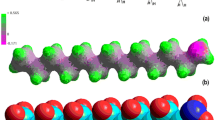Abstract
Microcystis aeruginosa immobilized in a natural polymer was tested for its potential to remove Cu2+ ions from aqueous solution in a continuous, downflow packed columnar reactor. Various parameters like flow rate, bed height and contact time required for maximum removal of test metals by the immobilized Microcystis aeruginosa were optimized. An increase in bed height from 2 to 10 cm resulted in an apparent decrease in biosorption capacity from 8.94 to 5.34 mg g−1, but more Cu2+ solution was purified at the higher bed height. Efficiency of metal recovery from Cu2+-loaded biomass and its subsequent regeneration was also determined. Immobilized M. aeruginosa was found to be effective in Cu2+ removal from solution for up to 10 cycles of adsorption–desorption and 1 M HCl is very efficient desorbent for regeneration of Microcystis biomass for reuse.
Similar content being viewed by others
References
Aksu, Z. & Kutsal, T. 1998 Determination of kinetic parameters in the biosorption of Cu(II) on Cladophora sp. in a packed bed column reactor. Process Biochemistry 33, 7-13.
Aloysius, R., Karim, M.I.A. & Ariff, A.B. 1999 The mechanism of cadmium removal from aqueous solution by nonmetabolizing free and immobilized live biomass of Rhizopus oligosporus. World Journal of Microbiology and Biotechnology 15, 571-578.
Brady, D., Stoll, A. & Duncan, J.R. 1994 Biosorption of heavy metal cations by non-viable yeast biomass. Environmental Technology 15, 429-438.
Chang, J.S., Law, R. & Chang, C.C. 1997 Biosorption of lead, copper, and cadmium by biomass of Pseudomonas aeruginosa PU2. Water Research 31, 1651-1658.
Chang, J.S. & Huang, J.C. 1998 Selective adsorption/recovery of Pb, Cu and Cd with multiple fixed beds containing immobilized bacterial biomass. Biotechnology Progress 14, 735-741.
Chu, A.U., Hashim, K.H., Phang, S.M. & Samuel, V.B. 1997 Biosorption of Cadmium by algal biomass: adsorption and desorption characteristics. Water Science and Technology 35, 115-122.
Fourest, E. & Roux, J.C. 1992 Heavy metal biosorption by mycelial by-products: mechanism and influence of pH. Applied Microbiology and Biotechnology 37, 399-403.
Kratochvil, D. & Volesky, B. 1998 Advances in the biosorption of heavy metals. Trends in Biotechnology 61, 291-300.
Hu, M.Z.C. & Reeves, M. 1997 Biosorption of uranium by Pseudomonas aeruginosa strain CSU immobilized in a novel matrix. Biotechnology Progress 13, 60-70.
Huang, C. & Huang, C.P. 1996 Application of Aspergillus oryzae and Rhizopus oryzae for CuII removal. Water Research 30, 1985-1990.
Meikle, A.J., Gadd, G.M. & Reed, R.H. 1990 Manipulation of yeast for transport studies: critical assessment of cultural and experimental procedure. Enzyme Microbial technology 12, 865-872.
Parker, D.L. 1982 Improved procedures for the cloning and purification of Microcystis cultures (Cyanophyta). Journal of Phycology 18, 471-477.
Pradhan, S. & Rai, L.C. 2000 Optimization of flow rate, initial metal ion concentration and biomass density for maximum removal of Cu2+ by immobilized Microcystis. World Journal of Microbiology and Biotechnology 16, 579-584.
Sag, Y., Nourbakhsh, M., Aksu, Z. & Kutsal, T. 1995 Comparison of Ca-alganite and immobilized Zooglea ramigera as sorbents for copper(II) removal. Process Biochemistry 30, 175-181.
Sandau, E., Sandau, P., Pulz, O. & Zimmermann, M. 1996 Heavy metal sorption by marine algae and algal by products. Acta Biotechnology 16, 103-119.
Tsezos, M. 1986 Adsorption by microbial biomass as process for removal of ions from process or waste solutions. In Immobilization of Ions by Bio-sorption, eds. Eccles, H. & Hunt, S. pp. 201-218, Chichester, UK: Ellis Harwood. ISBN 0-74580003-3.
Volesky, B. & Prasetyo, I. 1994 Cadmium removal in a biosorption column. Biotechnology and Bioengineering 43, 1010-1015.
Volesky, B. & Holan, Z.R. 1995 Biosorption of heavy metals. Biotechnology Progress 11, 235-250.
Wilhelmi, B.S. & Duncan, J.R. 1996 Reusability of immobilized Saccharomyces cerevisiae with successive copper adsorption-desorption cycles. Biotechnology Letters 18, 531-536.
Wilkinson, S.C., Goulding, K.H. & Robinson, P.K. 1990 Mercury removal by immobilized algae in batch culture systems. Journal of Applied Phycology 2, 223-230.
Author information
Authors and Affiliations
Rights and permissions
About this article
Cite this article
Pradhan, S., Rai, L. Copper removal by immobilized Microcystis aeruginosa in continuous flow columns at different bed heights: study of the adsorption/desorption cycle. World Journal of Microbiology and Biotechnology 17, 829–832 (2001). https://doi.org/10.1023/A:1013800800176
Issue Date:
DOI: https://doi.org/10.1023/A:1013800800176




